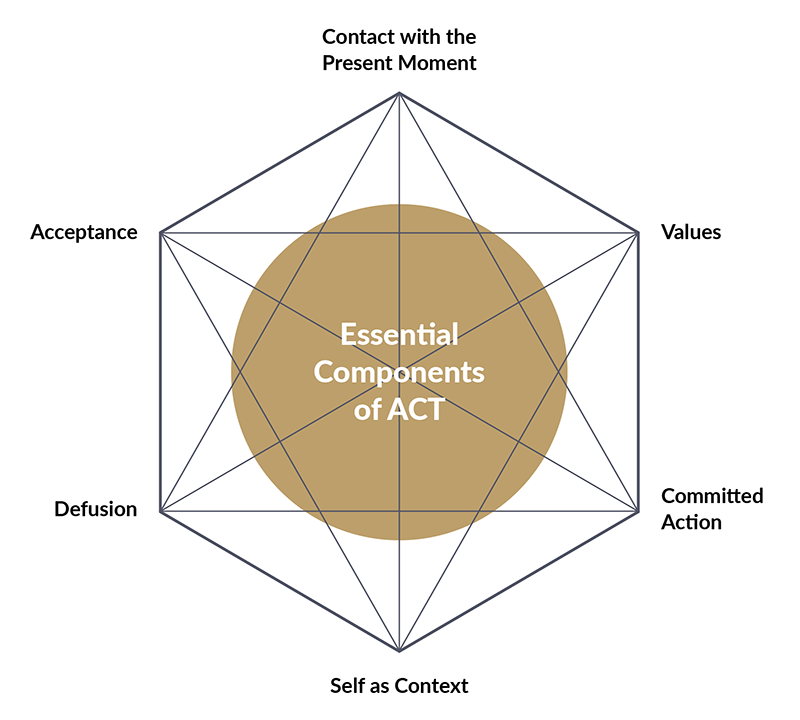How to Apply ACT in Group Therapy: 3 Workshop Activities
 Offering Acceptance and Commitment Therapy (ACT) in groups benefits participants by providing support when clients realize they are not alone with their struggles.
Offering Acceptance and Commitment Therapy (ACT) in groups benefits participants by providing support when clients realize they are not alone with their struggles.
Working in groups also facilitates learning healthy ways of relating to others and keeps clients accountable when learning new skills and better ways of coping.
The ACT approach is collaborative and especially suitable for group work because group members benefit from each other as collaborators, not just their therapist.
This article will introduce Acceptance and Commitment Therapy and explore its application to group work.
Before you continue, we thought you might like to download our three Positive Psychology Exercises for free. These science-based exercises explore fundamental aspects of positive psychology, including strengths, values, and self-compassion, and will give you the tools to enhance the wellbeing of your clients, students, or employees.
This Article Contains:
What Is Acceptance and Commitment Therapy?
Acceptance and Commitment Therapy (ACT) is one of the third-wave cognitive behavioral therapies that combine mindfulness and acceptance strategies with value-driven behavioral change (Hayes, 2004).
ACT aims to increase psychological flexibility as the cornerstone of optimal functioning and mental health. This is achieved by overcoming the experiential avoidance that leads to suffering.
ACT familiarizes clients with the healthiest aspects of their psychological functioning and equips them with the skills required to help these become the driving force of thinking, feeling, and behaving. Living a more fulfilled life then becomes possible.
The founder of the ACT approach, professor Steven C. Hayes, created a model he calls the hexaflex that illustrates the six core processes of ACT, presented in the diagram below (Hayes & Smith, 2005):
According to the ACT model, four of the six core processes involve equipping clients with mindfulness skills:
- Contact with the present moment
- Acceptance
- Defusion (often called “cognitive defusion”)
- The observer self (called “self as context” above)
The other two processes, values and committed action, are the key drivers of behavioral change.
All six core processes are highly interdependent. As one process is addressed, others are likely to emerge. There is no correct order for addressing these processes as they arise in the context of each client’s unique life history and current circumstances. However, an introduction to ACT usually begins with identifying the values that will steer the client’s desired life directions away from suffering and toward greater fulfillment.
How to Do ACT Group Therapy

This ultimate group therapy guide suggests seven group ice breakers and five group guidelines and rules that can be used to maintain healthy boundaries and clarify expectations of group members. They help keep group members safe.
However, for those who are new to the approach, Westrup and Wright (2017a) note two potential obstacles to ACT group work with clients who will have different levels of awareness of their problems and express varying degrees of openness to learning the skills required to overcome them.
- ACT is counter-orthodox
Traditionally, psychological therapies and other mental health interventions try to fix people. However, the ACT approach is different because the therapist helps the client see that they are already whole, acceptable, and possess the capacities they need to live a meaningful and fulfilling life.
The ACT therapist equips clients with the skills needed to navigate their way through life’s inevitable ups and downs.
- ACT is counterintuitive
ACT challenges the human tendency to trust what our mind tells us and take it as the literal truth. For example, the idea that suffering and discomfort are not necessarily wrong, but part and parcel of living fully is not what the human mind tends to believe.
Also, human beings gain a sense of identity by conducting a series of evaluations that place us in certain categories, yet ACT requires clients to query this process. Group members who hold on to certain aspects of their identity tightly may find this challenging.
ACT group work is psychoeducational and prioritizes experiential over verbal learning. Asking group members about their struggles, followed by an introduction to “noticing” rather than identifying with struggles, can motivate participants to engage with the exercises that follow.
ACT applies mindfulness skills to steering value-driven behavioral change. This short video by ACT therapist Dr. Russ Harris clarifies the differences between values and goals and can be useful when introducing the group to the importance of values and the benefits of ACT.
Given that ACT is psychoeducational, collaborative, and time limited, you can plan each session ahead to ensure it includes reviewing homework (best conducted in pairs), experiential exercises, and group reflection.
It is best to focus on individual exercises for homework. ACT is offered within a limited number of sessions, making it possible to plan ahead while remaining responsive to the group process.
“In order to help group members build psychological flexibility, we rely both on psychoeducation and direct experience” (Westrup & Wright, 2017a, p. 58).
Therapists familiar with ACT may find the three behavioral pillars of ACT (Hayes, Strosahl, & Wilson, 1999) useful for guiding group sessions as follows:
- Pillar one: Open (ACT processes: willingness and defusion)
- Pillar two: Centered (ACT processes: contacting the present, self as context)
- Pillar three: Engaged (ACT processes: values and committed action)
Experienced ACT therapists can use the three pillars to determine a structure for each session and work in the moment by devising exercises in response to the direct experience of the group.
This enables the therapist to model psychological flexibility. However, for those new to ACT, some exercises, worksheets, and group work manuals are suggested in the sections below. In addition, we suggest you peruse our article Acceptance & Commitment Therapy Training: Top 17 Courses.
6 Goals of Acceptance & Commitment Therapy
The main aim of ACT is to increase psychological flexibility by acquiring the cognitive and behavioral skills required to overcome experiential avoidance. Meanwhile, the learning goals of the six core processes comprise milestones on the ACT journey.
- Living a value-driven life rather than a goal-driven life. This involves choosing valued life directions rather than accomplishing a finite list of achievements. While clients need goals, their goals should always serve as milestones on a path determined by their values.
- Enhanced connection to the present moment through mindfulness. This reduces a tendency to dwell on the past or over-focus on the future and can help ease symptoms of depression and anxiety (Hofmann, Sawyer, Hitt, & Oh, 2010).
- Acceptance of the present moment and all the uncomfortable thoughts and feelings that may arise. This is required to cultivate psychological flexibility and resilience to the inevitable ups and downs of life.
- An ability to defuse from painful thoughts and feelings, rather than identify with them. For example, rather than having the thought, “nobody cares,” a client can use cognitive defusion to reframe the thought as, “I am having the thought that nobody cares,” or even, “I notice I am having the thought that nobody cares.” Cognitive defusion was originally called comprehensive distancing. It enables a client to observe their inner experience while choosing to take action in service of their values despite their uncomfortable thoughts and feelings.
- A reorientation to “self as context,” also called the “observing self” (Harris, 2008), as the source of nonjudgmental awareness. This displaces the orientation to “self as content,” which involves the fusion of identity with the content of thoughts and feelings that leads to suffering. Instead, the observing self witnesses all experience without comment and is the foundation of mindfulness and acceptance.
- Committed action in service of value-driven life goals. ACT teaches clients how to use mindfulness skills to take action in line with their values, regardless of what their mind tells them. Action planning, by setting short-, medium-, and long-term goals, steers the behavioral change required to enjoy a more fulfilling life.
3 Group Activities & Exercises for Your Sessions

1. Noticing the room
Convey the benefits of mindfulness/connection with the present moment.
This short exercise shows what happens when group members focus their attention on the present moment.
First, ask group members to leave their chairs and take a walk around the room. As they do, ask them to notice the room as if they have never seen it before. Tell them to look around thoroughly, as if they were at an art exhibition taking in everything on display.
Ask them to notice more than the objects in the room, by paying attention with all their senses, including the temperature, lighting, sounds, smells, colors, shapes, and so on. Continue this for about 10 minutes, then ask the group to take their seats.
Next, ask the group members to share what they hadn’t noticed before. You can use group members’ comments to model acceptance and collaborative learning by reinforcing those things you also hadn’t noticed previously; for example, by saying, ‘Yes, you’re right. I hadn’t noticed that.’
You can point out how often we all get so caught up in our minds that we fail to notice what is right in front of us. You can explain how going through life on ‘autopilot’ (mindlessness) is an everyday experience that undermines our capacity to be present (mindfulness).
2. Setting your intentions
Focus on committed action.
Ask group members to settle in their seats and close their eyes. Guide them to take a few deep breaths while focusing their attention on their breath. Pause.
Then, slowly lead group members through the following exercise.
“You are embarking on a new day. The only thing you really have in life is this moment. (Pause) Notice that this moment leads to the next, and the next, and so on… and all these moments will add up to today. Today leads to tomorrow. A new day is in front of you and awaits you. What would you like to do with this day? There are new possibilities in this very moment. And this one. And this one. As you experience the moments of this day, ask yourself how you would like this day to unfold. How do you intend to use your time today? (Pause) Think about how you can invest your time with purpose right here, today. Set your intention there. (Pause) When you are ready, return your focus to the room.”
3. The label parade
Illustrate the observer self/self as context and demonstrate fusion and defusion.
To conduct this activity, you will need sticky notes and a marker. You can do this exercise in a circle and use a member of the group as a “helper.” When working with one group member to generate a flow of thoughts and feelings, you ask a peer sitting next to them to do the sticking.
This exercise creates a tactile and visual representation of the distinction between the experiencer and experiences. This is achieved by writing some thoughts, feelings, or sensations a group member is struggling with on a sticky note and attaching it to that individual.
Once this visual has been created, the group is guided to notice that the individual carrying the label is a person rather than a collection of labels.
First, choose a group member and remind them of a frequently expressed experience, perhaps a thought about themselves. For example, you might say to client A “So A, you often say you ‘don’t feel good enough.’ Is that right?” Client A “Yes, that’s right.” At this point, you write “not good enough” on a sticky note and hand it to the person sitting next to them (now your helper), asking them to stick it on client A.
There may be some laughter in the group as the exercise unfolds. Humor is fine, because it can help client A defuse from the thought “I’m not good enough.” However, you should be careful to convey that what client A is sharing is important and treat it with respect.
Next, you ask client A if any other thoughts or feelings accompany “I’m not good enough.” Client A might say “I’m a loser.” You then write “loser” on a sticky note and ask your helper to stick it on client A. You repeat this until client A has several labels, as time allows.
You are trying to get a flow of experience going to demonstrate how the mind produces an ongoing commentary. At this stage, the exercise is demonstrating visually that client A is not just the content of these labels; the client carries this content but is not this content.
You can include all group members in this exercise. Once every group member is labeled with sticky notes, you invite them to stand in two groups in opposite corners of the room.
Next, ask them what they see facing them. Ask them if they see each other as the collection of words on the labels. Usually, group members will see their peers as whole people, as friends.
Then, ask them to walk around the room, pointing out that although each of them carries all this content, they remain free to move. You can conclude the exercise by saying, “Even when we carry many painful thoughts and feelings, we can still head in a new direction.”
The objective is to demonstrate how each group member is more than the content of the labels attached to them; they can carry this content and still move in a chosen life direction.
ACT Group Therapy: A Curriculum & Manual
You can use our ACT Worksheets and Ways to Apply Acceptance & Commitment Therapy article to support your ACT group work.
In addition, you can also download the Idiot’s Guide to ACT in Groups (automatic download) from the Association of Contextual and Behavioral Science.
The ACT for Life Group Intervention for Psychosis Manual (Oliver, Morris, Johns, & Byrne, 2011) is another free resource aimed at specialist mental health clinicians and published by the UK Institute of Psychiatry.
Finally, you can consult the workbook referenced in this article, Learning ACT for Group Treatment by Westrup and Wright (2017a).
Our Best Resources: Mindfulness X and Toolkit
If you want to learn more, our Mindfulness X program offers a comprehensive eight-session mindfulness training package based on scientific research. The course includes videos, worksheets, exercises, and slides, and can be taught under your own branding.
In addition, our Positive Psychology Toolkit© contains over 400 exercises, meditations, interventions, and other tools that you can apply to group work, as well as detailed explanations of the theory behind each practice.
A Take-Home Message
One-on-one therapy has its efficacy, but involving clients in a group approach has a distinct set of benefits.
Of particular interest is Acceptance and Commitment Therapy, a third-wave cognitive behavioral therapy with an established evidence base in the scientific literature (Hayes, 2021).
ACT in a group setting is based on a collaborative approach between the therapist and group participants. Because group work is limited to a specific number of sessions, therapists can plan activities ahead of time, while working with direct experience in response to the group process.
In addition to the benefits for the therapist, ACT group work also benefits participants by providing them with immediate peer support as well as therapeutic guidance during a focused period of psychological healing, development, and transformation.
Even though group ACT may be considered counter-orthodox and counterintuitive by some, the focus on helping clients live a more fulfilled life and equipping them with positive skills is fundamental to the success of this approach.
We trust that the activities and exercises shared above will encourage mental healthcare practitioners to consider this impactful group therapy approach.
We hope you enjoyed reading this article. Don’t forget to download our three Positive Psychology Exercises for free.
- Harris, R. (2008). The happiness trap. Robinson.
- Hayes, S. C., Strosahl, K., & Wilson, K. G. (1999). Acceptance and commitment therapy: An experiential approach to behavior change. Guilford Press.
- Hayes, S. C. (2004). Acceptance and commitment therapy, relational frame theory, and the third wave of cognitive and behavioral therapies. Behavior Therapy 35(4), 639–665.
- Hayes, S. C., & Smith, S. (2005). Get out of your mind and your life: The new acceptance and commitment therapy. New Harbinger Publications.
- Hayes, S. C. (2021). State of the ACT evidence. Association for Contextual Behavioral Science. Retrieved from https://contextualscience.org/state_of_the_act_evidence
- Hoffman, S. G., Sawyer, A. T., Witt, A. A., & Oh, D. (2010). The effect of mindfulness-based therapy on anxiety and depression: A meta-analytic review. Journal of Consulting and Clinical Psychology, 78(2), 169–183.
- Oliver, J., Morris, E., Johns, L., & Byrne, M. (2011). ACT for life: Group intervention for psychosis manual. South London and Maudsley NHS Foundation Trust/Institute of Psychiatry. Retrieved from http://drericmorris.com/wp-content/uploads/2014/10/ACT-for-Life-Groups-Manual-2012.pdf
- Westrup, D., & Wright, M. J. (2017a). Learning ACT for group treatment: An acceptance and commitment therapy skills training manual for therapists. New Harbinger Publications.
- Westrup, D., & Wright, M. J. (2017b). Learning ACT for group treatment: Supplemental exercises. New Harbinger Publications. Retrieved from https://www.scribd.com/document/436026515/23994-LearningACTGroupTreatment-Exercises
Read other articles by their category
- Body & Brain (42)
- Coaching & Application (54)
- Compassion (26)
- Counseling (50)
- Emotional Intelligence (24)
- Gratitude (18)
- Grief & Bereavement (21)
- Happiness & SWB (40)
- Meaning & Values (25)
- Meditation (20)
- Mindfulness (44)
- Motivation & Goals (43)
- Optimism & Mindset (32)
- Positive CBT (25)
- Positive Communication (20)
- Positive Education (45)
- Positive Emotions (30)
- Positive Leadership (14)
- Positive Psychology (32)
- Positive Workplace (33)
- Productivity (16)
- Relationships (41)
- Resilience & Coping (34)
- Self Awareness (20)
- Self Esteem (36)
- Software & Apps (13)
- Strengths & Virtues (30)
- Stress & Burnout Prevention (34)
- Theory & Books (44)
- Therapy Exercises (35)
- Types of Therapy (58)




